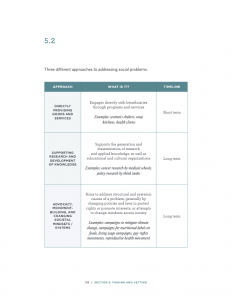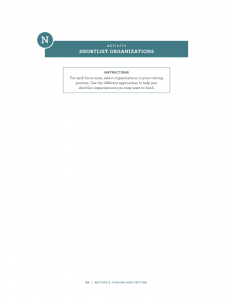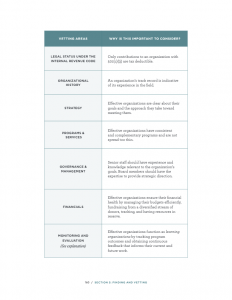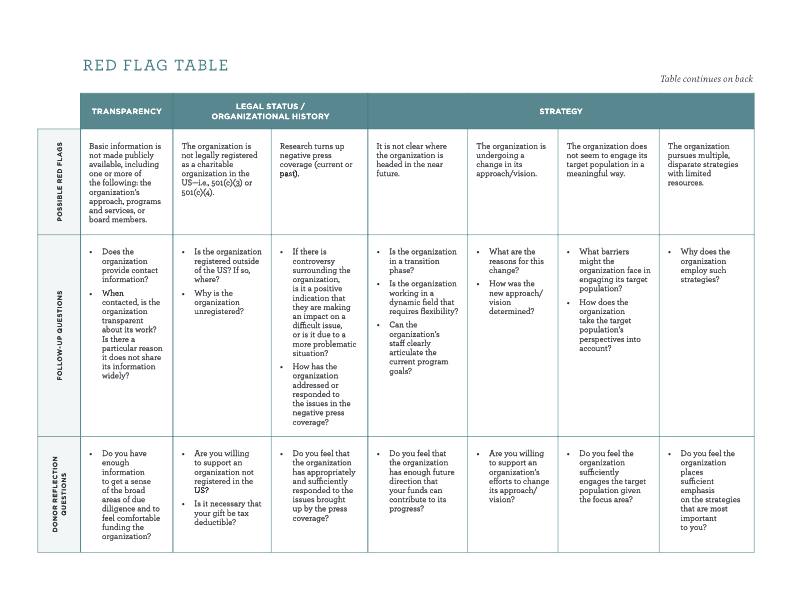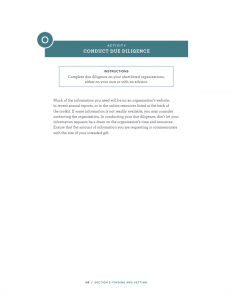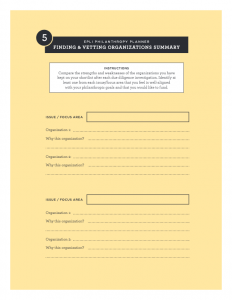Finding and Vetting Organizations
-
5.1 Find focus-aligned organizations
Proactively identifying organizations to fund, rather than reactively responding to miscellaneous funding requests, makes it more likely that you will support organizations aligned with your philanthropic goals. The search process also helps you learn more about the landscape of your focus areas, making your philanthropy more effective. You will take two main steps to find organizations: seeking recommendations from your networks and researching online.
Seek recommendations from your networks
If you have family, friends, or professional acquaintances with significant experience in your focus areas, consider asking them to recommend organizations that they know of or volunteer with. Make sure you understand the depth of their experience with their recommended organizations, why they recommend them, and what biases may affect their recommendations.
You can also seek recommendations from issue-area experts. For example, you may ask a friend who is a human rights lawyer about organizations supporting immigrant rights, or an oncologist about current cancer research. Experienced donors in your focus area are another good source of recommendations.
Professional philanthropic advisors and donor networks can also help you identify effective organizations working in your focus areas. Refer to the Philanthropist Resource Directory (PRD) database on our website for information on professional philanthropic advisors and donor networks who are familiar with your areas of interest. pacscenter.stanford.edu/prd
If you are looking for place-based funding recommendations, community foundations often understand the local landscape of nonprofit organizations. The Council on Foundations has a publicly available tool you can use to search for community foundations by location. cof.org/community-foundation-locator
Research online
Use the Internet to find organizations in your focus areas. The following resources will be helpful in your search.
ONLINE SEARCH ENGINESA focused online search is the most comprehensive way to find nonprofit organizations. The more specific you are about your focus areas, the more likely your search query is to be useful.
Create targeted search queries by including your issue or focus area, the populations or groups you want to help, and (if relevant) your geographic interests. Note that you may want to change the word order of your search queries depending on your personal preferences. For example, if you are more interested in a particular population than a specific location, place the population before the location. Here are a few examples of searches that provide focused results:
nonprofit organization education low income students in Boston
nonprofit mental health services in Wisconsin for youth
charities global health women organizations
ORGANIZATIONS’ WEBSITES Look on the website of each organization that is a candidate for your giving for pages with titles like “About Us” or “About [the Organization]” and “Programs and Services,” and read them carefully to see how the organization aligns with your focus area. If you are interested in volunteering with the organization before making a gift, look for titles like “Get Involved” to look up ongoing volunteer activities, or see if the organization has any public events or benefits you might attend.
Note that maintaining a sophisticated website requires significant resources that an effective organization may have chosen to direct elsewhere; website design does not necessarily correlate with the organization’s effectiveness.
CURATED ONLINE LISTS OF ORGANIZATIONS You can also use curated online lists to learn about more organizations. Here are some places you can find these lists.
Foundation grantee lists Foundations have specialized professional staff who thoroughly vet nonprofit organizations before funding them. Many large foundations share a list of their grantees online. Search for foundations aligned with your philanthropic goals, and then look at their grantees.
If you have trouble identifying relevant foundations, consider using the Foundation Center’s fee-for-service Foundation Maps tool, which provides easy-to-read visuals of foundations and grantees that can be organized by issue area and geography. Note that in 2019, the Foundation Center and GuideStar joined forces to become Candid. maps.foundationcenter.org
Issue funds Issue funds can help you learn about organizations that work on a particular issue or focus area. Overseen by a fund manager with expertise in a subject, issue funds aggregate donor contributions and distribute them to relevant nonprofit organizations. For more information on issue funds and how to find them, see Additional Resources: Section 5 at the end of this toolkit.
Lists curated for humanitarian, emergency, and disaster relief At the time of a natural disaster or humanitarian crisis, community foundations and charitable arms of financial institutions often provide curated lists of nonprofit organizations addressing humanitarian, emergency, and disaster
relief. These lists guide donors to relief and rebuilding efforts. Each organization has its own methodology for assessing a nonprofit’s effectiveness. In addition to meeting immediate needs through emergency giving, proactive gifts can sustain disaster preparedness efforts in vulnerable communities and long-term recovery in post-crisis communities. For more information on disaster philanthropy, see Additional Resources: Section 5 at the end of this toolkit.
GiveWellGiveWell is a nonprofit organization, primarily focused on global poverty, health, and direct aid. It recommends a short list of cost-effective, underfunded organizations based on rigorous research. Each of its recommendations explain how GiveWell assessed the organization’s effectiveness. givewell.org
NONPROFIT DATABASES GuideStar Charity CheckGuideStar Charity Check, now under the nonprofit entity Candid, provides snapshots of more than 1.5 million IRS-registered nonprofit organizations in the United States, with information about each organization’s mission, programs, outputs, outcomes, financial standing, and leadership. Although all information is self-reported, each organization is given a transparency rating based on the information it shares: Bronze for providing basic information; Silver for including financial data; Gold for providing data on organizational impact; and Platinum for providing data from the previous tiers as well as the metrics used to evaluate progress toward its mission. In other words, GuideStar Charity Check remains neutral about content, rating organizations only on the availability of self-reported information. GuideStar Charity Check also provides additional filters and affiliation searches to paid premium and professional accounts. guidestar.org
Charity NavigatorCharity Navigator rates over 9,000 US-based nonprofit organizations that have generated at least $1 million in revenue for two consecutive years. Its rating scale of one to four stars is based on financial health, accountability (willingness to explain actions), and transparency (willingness to provide information publicly). We do not recommend relying on Charity Navigator’s financial health measure, as its algorithm penalizes organizations with high overhead costs, and some organizations— especially those providing direct services—naturally have higher overhead costs due to the nature of their work. charitynavigator.org
Once you have a list of organizations you want to research further, you can begin looking up their financial health and leadership through Candid’s GuideStar Charity Check, or through Charity Navigator.
WHEN TO STOP YOUR SEARCH At some point, you will stop searching for organizations and begin vetting those on your list. What that point is depends on how many plausible candidates you’ve identified, how much time and capacity you have to devote to the process, and your own preferences for comprehensiveness. You may wish to ensure that you don’t miss any organizations in the field, or you may be satisfied after finding a handful of good candidates.
Landscape analysis
A landscape analysis helps you learn about the best research, strategies, stakeholders, organizations, and funders in your focus area. If you have limited time but want to make sure you have a strong grasp of the issue, stakeholders, other donor activity, and policies affecting your interest area, it is common to engage a consultant to create a custom landscape analysis for you. A landscape analysis can take a few weeks or a few months and generally begins with desk research—internet searches and literature reviews about a field. You (or the consultant) can supplement this by talking to principal stakeholders, including your intended beneficiaries, nonprofits, other funders, scholars, government officials, business leaders, and community members. For example, the landscape analysis and online funding map about ocean conservation below provides a comprehensive study of key stakeholders and priorities:
Landscape analysis examples:
https://www.issuelab.org/resource/launching-the-grand-challenges-for-ocean-conservation.html
Funding map example: http://fundingtheocean.org/
If you would like to conduct a landscape analysis on your own, please refer to Stanford PACS’ Guide to Effective Philanthropy for a DIY Landscape Analysis Activity in Chapter 7: Finding Effective Organizations which is available in print or on our website.
-
5.2 Understand how organizations can achieve their intended outcomes
The following comparison chart describes three different approaches to addressing social and environmental problems. The approaches are not mutually exclusive—donors, and even organizations, can use more than one approach. Use the charts to better understand the organization’s you have identified so far. Then reflect on whether some approaches might be better suited than others to achieving your philanthropic goals in a focus area.
These examples show how issues can be addressed using different approaches.
RESOURCE: APPROACHES CHART
Suggested printing instructions: Letter-sized, portrait, single-sided
ACTIVITY N: SHORTLIST ORGANIZATIONS
For each focus area, select organizations in your vetting process. Use the different approaches to help you shortlist organizations you may want to fund.
Suggested printing instructions: Legal-size, landscape, single-sided
-
5.3 Vet organizations
You can now vet the organizations you have shortlisted through the process of due diligence. Due diligence involves assessing an organization’s legal status, overall health, strategic direction, and programmatic impact. Completing this process thoroughly will enable you to make confident funding decisions.
Your due diligence on a nonprofit organization may raise red flags related to the organization’s operations, leadership, or programs. Not all red flags are necessarily deal breakers. Some may be challenges that exist for a fixed period of time (e.g., an executive director in transition, a temporary deficit in the current financial year), while others may be more pervasive or ongoing (e.g., lack of program data, lack of focus).
RESOURCE: EPLI Due Diligence Table
This table lists some common red flags encountered in due diligence. Consider the donor reflection questions related to each of the red flags to help you weigh their significance when deciding whether to support the organization. Ultimately, it is up to you to determine the weight a red flag will hold in your funding decision.
Suggested printing instructions: Legal-size, landscape, single-sided
Monitoring and Evaluation
Understanding how an organization learns from experience is an essential component of effective due diligence. We separate the learning process into two categories: monitoring and evaluation.
Organizations have a wide range of measurement and evaluation reporting practices, from very basic to quite sophisticated. Sophisticated program measurement and evaluation is resource-intensive and should not necessarily be expected from every organization. If identified as a primary need by the organization’s leadership, it is common for donors to support improving and expanding an organization’s measurement and evaluation strategy and implementation.
MONITORING
Monitoring is the systematic, routine collection of information from an organization’s programs and services, usually undertaken by the organization itself. Monitoring focuses on predetermined key indicators (qualitative or quantitative) that help organizations assess their performance, such as beneficiary engagement and feedback, program implementation, finances, and unintended harms. Highly effective organizations set targets for these indicators and measure their progress toward them. These targets should be SMART (specific, measurable, attainable, realistic, and timely). This enables organizations to learn from their work and continually refine their programs.
Evaluation
Evaluation helps organizations understand their programs’ effectiveness in achieving their intended outcomes. Evaluation can be carried out within an organization or by an external evaluator. Internal evaluation offers the benefit of deep contextual understanding, while external evaluation offers the benefit of outside expertise and credibility through a neutral third party.
Referring to the three basic approaches described in Section 5.2 on achieving social outcomes, it is usually easiest to evaluate the outcomes of service delivery programs and can be difficult to evaluate the outcomes of advocacy, field-building, and promoting knowledge—which often have long time horizons and depend on the contributions of many actors. In these cases, evaluations may be more qualitative than quantitative.
If you are interested in learning to more deeply assess an organization’s strategy and evaluation process, see Additional Resources: Section 5 at the end of this toolkit.
ACTIVITY O: CONDUCT DUE DILIGENCE
Complete due diligence on your shortlisted organizations, either on your own or with an advisor.
Much of the information you need will be on an organization’s website, in recent annual reports, or in the online resources listed at the back of the toolkit. If some information is not readily available, you may consider contacting the organization. In conducting your due diligence, don’t let your information requests be a drain on the organization’s time and resources. Ensure that the amount of information you are requesting is commensurate with the size of your intended gift.
Suggested printing instructions: Legal-size, portrait, double-sided

